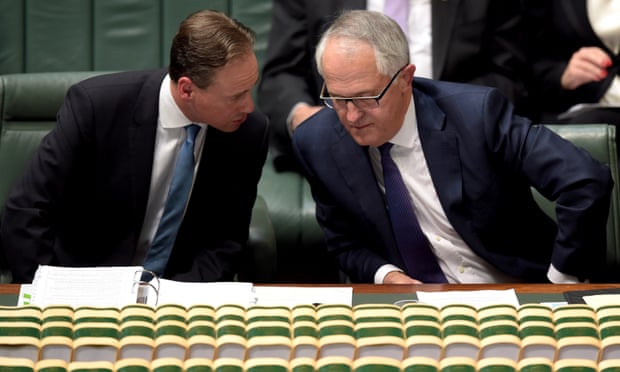Staff at the Australian Renewable Energy Agency were told on Monday they were being transferred from industry department to department of the environment
 |
| Australian prime minister Malcolm Turnbull (right) speaks to Australian environment minister Greg Hunt in Parliament House, Canberra. Photograph: Lukas Coch/AAP |
The Turnbull government is signalling a new approach to climate policy despite its pledge to stick with the “Direct Action” climate plan, abandoning Tony Abbott’s attempt to abolish two key renewable energy agencies and considering tougher “safeguards” to ensure the policy actually reduces emissions.
Staff at the Australian Renewable Energy Agency (Arena), a body set up by the former Labor government to increase the use of renewable energy, were told on Monday they were being transferred from the industry department to the department of the environment.
The Clean Energy Finance Corporation, which finances clean energy projects on a commercial basis and which Abbott had ridiculed as the “Bob Brown bank” and sought to abolish or ban from investing in wind or small scale solar, is also being transferred to environment minister Greg Hunt’s portfolio. It previously answered to the treasurer and the finance minister.
Sources said the transfer of the agencies was a clear signal they were no longer slated for abolition. The Senate twice voted down the Abbott government’s attempts to abolish the CEFC. Legislation to abolish Arena has been before the Senate for a year.
Hunt told Sky news on Monday that “obviously under Malcolm Turnbull there is a history of a deep long support for renewable energy.”
It is also likely the government will drop or amend the ban on the CEFC investing in wind or small scale solar. The government has been in negotiation with the CEFC over its investment instructions for several months after the investment bank got legal advice that suggested the Abbott government order could contradict its legislated duties. An agreed way forward was set to be announced any day.
Hunt said the CEFC was “coming back to the government with proposals that might be flexible and we will look at that in time.”
The government will also be presented with an immediate chance to improve the effectiveness of Direct Action by toughening the so-called “safeguards mechanism”, which is supposed to make sure rising industrial emissions do not undo any emission reductions purchased through the $2.5bn emissions reduction fund (ERF).
The government had released a draft safeguard mechanism and the deadline for responses was Monday, the same day the new ministry was sworn in.
The government could be forced to toughen the rules in negotiations to make sure they are not disallowed by the Senate. Independent senator Nick Xenophon has accused the coalition of reneging on a promise of “credible” safeguards made to secure his critical vote for the Direct Action legislation. He has proposed amendments to give the scheme “teeth”.
Market analyst Reputex says the new rules, as proposed, leave major industry “largely free to grow their emissions” because the “baselines” have been set too high to make any difference and industry has been given even more ways to avoid penalties if they are exceeded.
Reputex says the detailed rules confirm none of Australia’s top 20 emitting facilities – including brown coal-fired power stations Loy Yang A and B and Hazelwood, and new liquefied natural gas processing facilities such as Wheatstone, Gorgon, Itchys and Pluto – will be forced to reduce emissions.
But Reputex has also suggested a change that could give the rules “baby teeth” – and the amendment is likely to be backed by some of the Senate crossbench.
Most analysts believe the current policy has little chance of meeting the long term targets adopted by the Abbott government and reaffirmed by Malcolm Turnbull – to reduce Australia’s emissions by 26-28% by 2030.
The government has promised to review the safeguards mechanism in 2017, to allow for changes to ensure it meets the 2030 target.
The suggestion is it promise the “baselines” set for industrial emissions will begin to decline from that time – a move that would over time turn the mechanism into a baseline and credit emission trading scheme.
The safeguards mechanism applies to facilities with more than 100,000 tonnes of emissions a year.
Asked about the safeguards mechanism last week, Hunt said “that’s always been designed as a flexible, long-term mechanism – not to 2020 but to 2030, and I hope beyond. So, by definition, it’s been designed in a flexible way.”
Turnbull lost the Liberal leadership in 2009 over his backing for then prime minister Kevin Rudd’s emissions trading scheme. Since becoming prime minister he has emphasised the important thing is to reduce emissions, rather than being “ideological” about the mechanism used to do so.

No comments :
Post a Comment